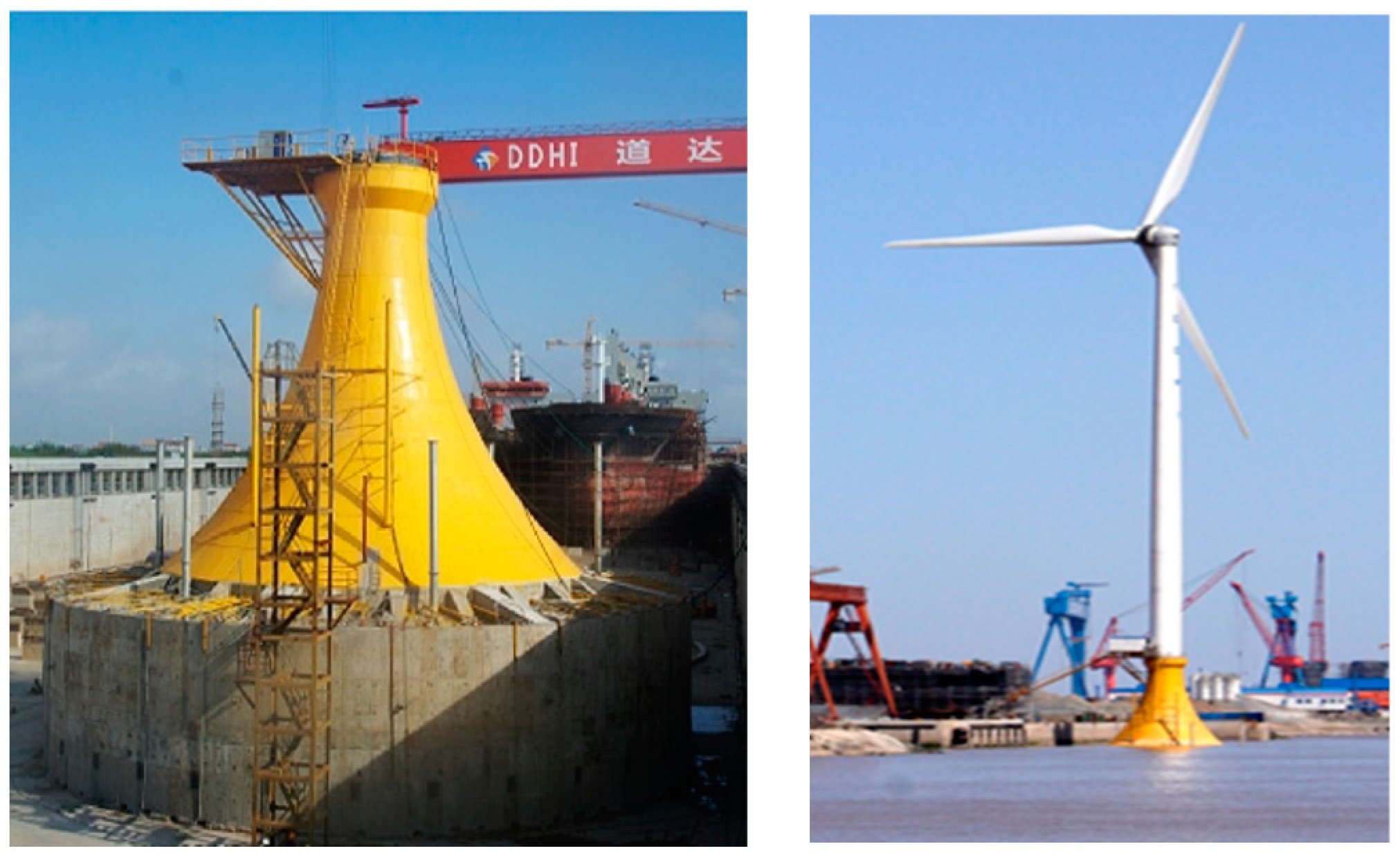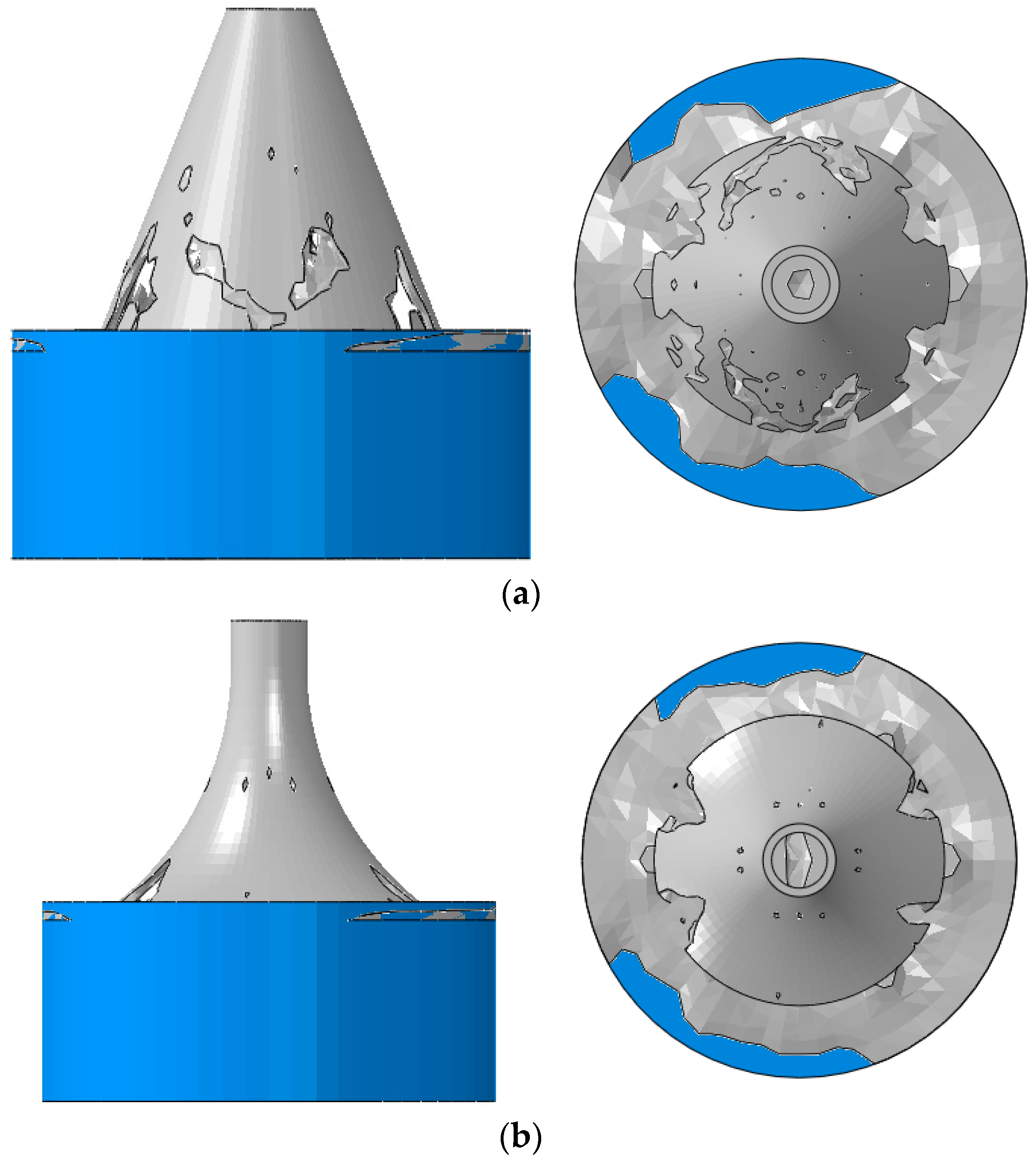1. Introduction
Offshore wind power has a huge development potential. However, along with its applications, a series of technical problems have also been encountered, among which the optimization design of the lower part of a wind turbine tower is still not well solved. As the core part of the overall wind turbine construction, the wind turbine foundation faces a complex working environment, including wind, wave, and current, which places higher demands on its safety, reliability, and corrosion resistance of various components [
1]. In general, the cost of design, construction, installation, operation, and maintenance of a wind turbine infrastructure accounts for more than 40% of the total cost. To make the infrastructure more economical and reasonable, each part of the foundation should play a better role in reducing the construction cost.
A series of studies on the response to force conditions of the bucket foundation were conducted in China and other countries. In 1999, Bransby and Randolph [
2] studied the failure envelope of bearing capacity of a bucket foundation under different combinations of load components in different directions. In the same year, Shi et al [
3] carried out a horizontal bearing capacity model test of bucket foundation in soft soils, analyzed the displacement of bucket body under horizontal load and its interaction with soils, and put forward a formula for calculating the horizontal bearing capacity of a single-bucket foundation. In 2000, Liu et al. [
4] obtained the distribution of earth pressure in the active and passive zones of the bucket foundation through field model experiments and numerical simulations; using the limit equilibrium method, a formula for calculating the horizontal ultimate bearing capacity of a single-bucket foundation was also proposed. In 2002, Gourvenec and Randolph [
5] determined the failure modes of bucket foundations in heterogeneous soils through two- and three-dimensional finite element analysis and model tests as well.
The optimization of the force of offshore wind turbines were also studied. In 2010, Zhai et al. [
6] introduced a multi-factor and multi-level fuzzy optimization theory into the design and selection of wind turbine foundations, and made a multi-level fuzzy comprehensive optimization decision-making on 13 factors affecting the basic design and 4 forms of pile foundation, thus providing a novel idea for the design and selection of the wind turbine foundation. In 2012, Ding et al. [
7] used the finite element software ABAQUS to simulate the structural optimization degree of effective prestressed large-scale bucket foundations subjected to ultimate loads, and applied effective prestress of different sizes to the steel strands of arc-shaped transitional structures. In the same year, Lian et al. [
8] numerically analyzed the design of a 3 MW offshore wind turbine with a prestressed drum-type foundation structure, and analyzed the influence of arc-shaped transition tower segment on the structural stress. In 2017, Ding et al. [
9] took the bucket foundation of an off-shore wind power project as the research object, established a variety of trial calculation models for the initial bucket foundation structure, and optimized the tension transition stress, as well as the numbers of prestressed holes and steel strands using ABAQUS.
The optimization of the shape of offshore wind turbines was also extensively studied. To make the foundation cost more economical, Tove et al. combined actual offshore wind engineering projects in Europe to optimize the single-pile foundation [
10]. Kang and Zhang [
11] used ANSYS to optimize the deterministic size, shape, and fuzzy dimensions for a three-fan foundation. Wu [
12] proposed a limit reaction method to estimate the bearing capacity of bucket foundations and optimized the structural parameters. With an offshore wind power project as an example, Liu et al. [
13] adopted a numerical analysis method to study the influence of different characteristic parameters of size on the transmission of the bucket foundation and its resistance to bending moment loads. In recent years, more and more algorithms have been applied to fan-based optimization. By combining the pile foundation and tower monitoring data of a wind turbine loacated in Xiangshui Wind Farm, Jiangsu Province, China, Yang [
14] analyzed the response of a foundation-tower structure under dynamic loads (e.g., wind, waves, and earthquakes), and obtained the dynamic optimization design based on genetic algorithm. Liu [
15] applied the sequence quadratic programming (SQP) and the improved genetic algorithm to the overall structural optimization design of the bucket foundation for the first time. By combining the optimization method with the finite element method, Liu [
16] optimized the design of a 6 MW composite bucket foundation (CBF) with diagonal support. Based on the SQP optimization theory, Sun [
17] carried out deterministic size optimization of a composite pile foundation.
At present, the research on bucket foundations mainly focuses on optimization using finite element software; however, the member of optimization algorithms is limited. The traditional algorithms can only optimize the overall structure, but they cannot find the optimal force transmission path. The main methods for solving the optimal force transmission path include the analytical method based on Michell theory [
16,
18], the method of quantifying the force transmission path based on the bearing factor, and the numerical method based on topology optimization. Based on the quantification method of load-bearing path [
16,
18,
19], differential method is used to derive the differential equation of the shortest transmission path in the structure. However, for complex heteromorphic structures, differential equations are too complex to solve. Fortunately, topology optimization can solve the problem of shortest force path; its design variables are not specific dimensions or node coordinates as usual, but indicate the existence of sub-regions with independent levels. According to Kirsch [
20,
21,
22,
23,
24,
25,
26], topology optimization is the most difficult task in structural optimization. In recent years, with the development of computer technology, optimization design for structural topology has been improved substantially.
In this paper, the design of an offshore bucket foundation is optimized through topology optimization and mathematical programming. First, the optimal force transfer path in the structure and the economical and practical optimal structural scheme are determined according to constraints, load conditions, and optimization objectives. The topology of the transition section in six forms is optimized to search for the best transfer path. At the same time, finite element software ABAQUS is used to verify the six models. Then, the bucket type is selected, and mathematical programming method is used to analyze the optimization of CBF. With the minimum total weight of the structure as the objective and the shape parameters of each part as design variables, the SQP quadratic programming algorithm and hybrid genetic algorithm are used. Finally, the optimization objective function based on the offshore wind turbine type prototype is established, and the optimal parameters are obtained; the feasibility of mathematical programming in the optimization design of a complex structure is thus verified.
2. Mechanical Characteristics of CBF
Bucket foundation is a new type of offshore structure appearing first in the 1980s. Nowadays, it is mainly applied to the construction of offshore oil platforms, seawalls, and other man-made islands in the form of suction anchor offshore [
27]. In 2010, China’s first 2.5 MW large-scale CBF was installed in Qidong City (Jiangsu Province), marking a substantial progress in the development of bucket foundations, as shown in
Figure 1. In 2017, the one-step installation of a 3 MW prototype was carried out at the Xiangshui Wind Farm in Jiangsu Province, which was the beginning of a batch test of CBF, as shown in
Figure 2. At present, there are 13 composite bucket foundations under construction in Jiangsu Dafeng Wind Farm, of which 11 are of capacity 3.3 MW and two are of 6.45 MW.
As a kind of foundation with closed upper end and open bottom, it is similar to an inverted cup, mainly consisting of a steel cylinder body, a concrete ceiling, and a bucket cap beam structure [
9]. To meet the requirements of float-sink-leveling and provide strength reserves for the bucket foundation, a honeycomb-shaped partition plate structure is arranged in the cylinder body, thus dividing the foundation into separate compartments (see
Figure 3).
In the design of bucket foundation, the key is to solve the transfer of bending moments and horizontal forces. By designing a reasonable transition section, including its wall thickness, variation range of upper and lower opening diameters, prestressing force, and reinforcement, the coordination of the transition section (through which the bending moments and horizontal forces are transmitted from the tower to the top of the transition section), connecting ring beam, radial bucket top cap beam system, composite drum, and inner deck, is realized. Finally, the bending moments and horizontal forces can be effectively transferred and dispersed into the seabed soil. At the same time, through the optimized design of the transition section, the load can be transformed into the structure’s own limited tensile and compressive stress, thus the corrosion caused by the cracking in concrete can be avoided. In this way, the economic efficiency, durability, and reliability of the combined structural system (i.e., prestressed steel strand-steel plate-concrete) is guaranteed. The difficulty in the design of pre-stressed reinforced concrete composite structures comes from two aspects: (1) the force transfer mode of the entire structure is not clear; (2) and there is no relevant norm or experience for the design and calculation of the basic structure.


























